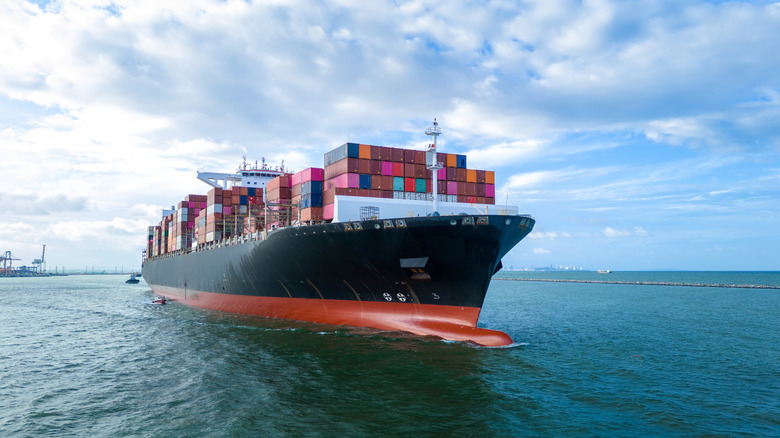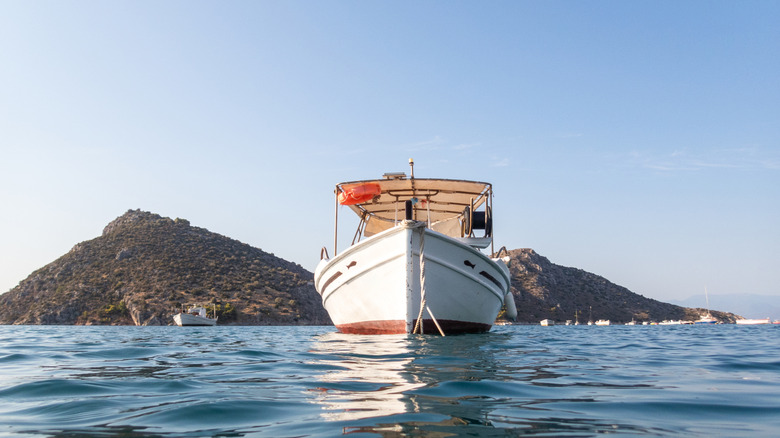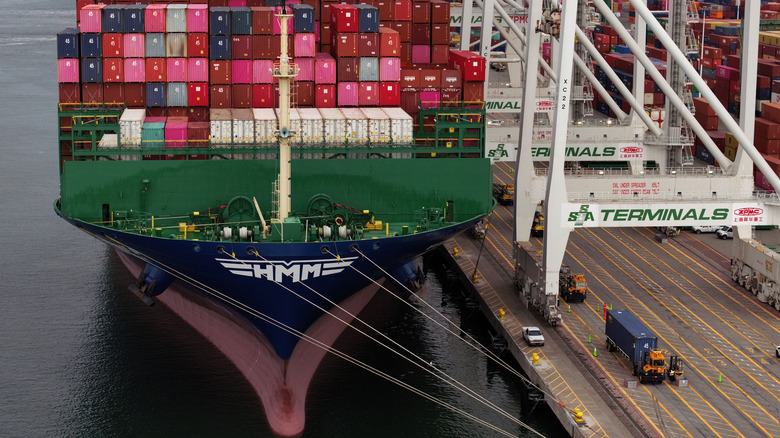This Is Why So Many Ships Are Painted Red On The Bottom
You've probably already noticed it by now. Many of the ships you've seen are painted red on the bottom. While they may have different colors on the top parts, from green or blue to the gray that is usually used on most military ships, the bottom part is usually a distinctive shade of red that is so common that it has become unnoticeable to many. Like with many things in the maritime industry, this color carries significant meaning, one that goes back centuries.
The red color you see is usually because of anti-fouling paint, which acts primarily as a biocide meant to deter organisms from attaching to the parts of the ship that are usually in contact with water. If these organisms, such as barnacles, worms, and weeds, were to attach themselves to the ship's hull, they would not only cause significant damage and add weight to the vessel, but also increase drag. This would slow down the ship and lead to greater wear and tear on the vessel's propulsion systems due to overexertion, as well as higher fuel consumption. But what exactly is in these anti-fouling agents that makes most of them red?
A ship performs optimally when its hull is clean
The answer lies in the copper oxide compound used in the anti-fouling paint, which is typically red. Like the paints used on land vehicles, the ones used on water vessels are specialized to serve different purposes, depending on the vessel to which they are applied. A good example is the black paint used by the military on submarines, which contains carbon black, perfect for resisting wear and tear and helping the submarine's hull withstand the pressures of diving and surfacing. In that respect, the copper oxide found in anti-fouling agents helps the ship reach its destination as quickly as possible.
Copper oxide is lethal to sea life, especially the ones that are known to attach to the hull of a ship. Picture this: A cargo ship leaves Asia, headed for the U.S. East Coast. The estimated time for the journey is between 26 and 36 days, provided everything goes as planned. However, the cargo ship in question has a barnacle and seaweed infestation, which severely affects its weight, speed, and fuel efficiency.
You can already see how this would impact not only the environment but also the freight company. Apart from a delayed delivery, the freight company now has to worry about fuel and repair costs. As a result, American consumers are left waiting for their products. This is why anti-fouling biocides are as important as they are. Like the black paint on submarines, they help ships perform at their best, which is when their hulls are clean and smooth.
Copper was used in ship sheathing before graduating into anti-fouling paints
Interestingly enough, modern times and technology have made it possible for ship owners to opt out of using this red color, as anti-fouling paints that aren't red do exist. However, having a ship with a red-painted bottom is seen by many as a historical nod to older times, when copper and copper-based anti-fouling paint were some of the best ways of keeping vessels safe from sea life.
Throughout history, sailors experimented with different types of sheathing (applying a layer of material on the exterior of the hull to prevent damage from marine organisms). Among the materials used was copper, which proved to be quite effective, especially in the 1700s when the British Navy was eager to ensure its ships worked optimally. However, copper sheathing had its own set of problems, which motivated researchers to develop even more effective methods of protecting ships from marine organisms.
In 1863, American business partners James Tarr and Daniel Wonson filed a patent for a copper-based paint, opening the doors to anti-fouling agents that worked great against barnacles, worms, and weeds. These paints became a staple in the navy and maritime industries, used widely across different vessels, from the fastest Navy ships ever constructed to luxury cruise ships, fishing vessels, and even personal boats.


